 Wine information
Wine informationWine making process
The differences between red and white wines
French wine history
Wines from Spain
Port wines from Portugal
Italian wine history
German wine history
Hungarian tokay wine
Wines from Algeria
Brandy wine
How to buy wine
Wine storage tips
Wine serving basics<
History of wine
Types of wine glasses
Selecting wine for meals
Wine region map
Wine dictionary
Wine serving basics
The wine owner needs a few tools and gadgets for his greater comfort and better security of his treasure. First of all a decent corkscrew. The narrow gimlet corkscrew (left on the image below), though suitable for the smaller beer cork, is not safe to use for wine. It may easily pull away, bringing the core of a perished cork with it.
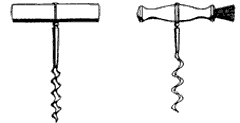
The corkscrew on the right, drawn to the same scale as the one on the left, is to be recommended. The section of the screw is flattened and edged, thus giving a better bite on the cork.
N.B. The brush should be used to brush away fragments of dust, wax, or cork after carefully removing the sealing-wax, but before drawing the cork. After the cork is drawn, the brush is more apt to push the particles into the bottle than to remove them.
In the case of an obstinate cork nothing is better than the double-lever extractor:
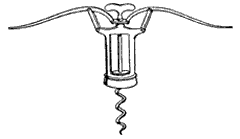
but care must be taken at the beginning of the stroke to see that the cork is coming and that the screw is not merely pulling through.
The tongs (see image below) should be at hand to save the wine if any such accident should happen to the cork. They are heated to a cherry-red; the neck is gripped just under the flange-when the glow has passed away (from half-a-minute to a minute).
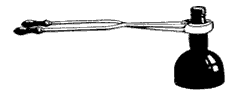
Remove the tongs, and, dipping a feather or piece of rag into cold water, apply it to the neck where the tongs have held it. It
will come off easily and cleanly.
The Crown cork-opener (see below), for aerated water-bottles, is now an indispensable accessory for the cellar.
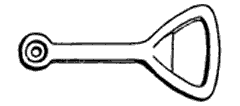
Hand-guards. When drawing a cork a guard should always be used. A cloth at least, or a leather guard which is slipped over the neck
(see below). One can never be sure there is not a flaw in the bottle, and a dangerous cut to hand or thigh is not worth risking.
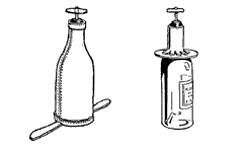
There exists a device with elevating gear like a turret-gun (but something smaller) for steady pouring of a fine old crusted Port. This seems to me overdoing it a little. Still, to do justice to a really old wine, 'twere best if the host and anyway, this is an impressive piece of 'business,' as they say in the theatrego down to his cellar and bring up the treasure in his own hands. No deputizing
can be adequate. The basket (see below), except in restaurants where the bottle and cork are produced as evidence of good faith, also seems to me something of a superstition. There is obviously,
except with the most tender handling, apt to be
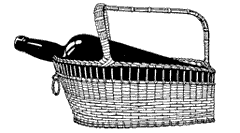
a `back swish' as the basket is set down. Better decant at once and eliminate the basket; or (in the restaurant) decant from the basket and dismiss it with its bottle, and enjoy the pleasure of the look of a fine wine in the decanter The eye helps the palate in all drinking of good wine.
I cannot quite agree with Dr. Mathieu's case against decanting, though distressed to find myself with, I imagine, most of my fellow wine merchants in opposition to such an authority.
Dr. Mathieu asserts quite truly that the wine in process of being decanted takes up oxygen, which changes the taste and perfume of the wine. Agreed. But the wine, anyway, must reach the oxygen before being drunk, unless we are to drink it at one draught from the bottle; and there is surely more likelihood of the back swish
of the bottle, whether poured from basket or hand, disturbing the sediment than really careful decanting. But the connoisseur-scientist's somewhat ecstatic description of how wine should be served and drunk seems to me so valuable that I add it as a footnote to this chapter.
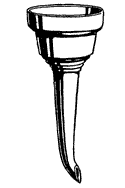
The decanting funnel (see above) is recommended for decanting good wine. It should always be perfectly clean boiled, in fact, before use and should be warmed to the temperature of the wine which is being decanted. The turned end of the funnel directs the wine down the side of the decanter and prevents 'frothing.'

The little hard wood `swizzler' (see above) is much in vogue with folk who do not care for highly-aerated waters or extra fizzy drinks. If 'sizzled' round in a glass of champagne it effectually releases the gases and reduces the effervescence.
For 'cups,' a double glass vessel (see below) is indispensable. The inner container holds the ice and is removed just before serving. The ice should not be put directly in the wine, because it may not always be perfectly clean, and because it dilutes and often 'clouds' the wine.
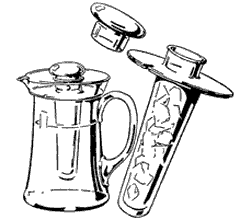
Decanting should always be done carefully. All wines throw some deposit; the deposit, in a sound wine, indicating improvement. This
deposit is not required for consumption, and should be left in the original bottle when decanting. Its presence in the decanter spoils not only the appearance but the flavour of the wine.
When decanting very old wines, such as Port, it is best, if possible, to remove the neck of the bottle below the cork with the tongs as above described.
When opening Champagne, remove all wire and foil before releasing the cork. Many a bottle of good wine has been spoiled by allowing the contents to run over mouldy string and rusty wire. Do not put ice into Champagne, but only around the bottle. Wine drunk too cold loses much of its fine flavour.
It is not, by the way, safe to decant two bottles of wine into the same decanter, not merely in case there should be anything wrong
with one of them, but because a supreme accidental character of one specially-favoured bottle may well be lost. Respect each bottle of
your fine wine as having temperament, individuality.
Having your good wine to decant, into what sort of vessel are you to decant it ? In general terms one answers: Into a vessel which shall
show off to best advantage the colour of the wine, which means certainly first of all into a vessel of pure white glass. Custom has decided that Port and Sherry shall be poured from solid, heavy, broad-based, or onion-bellied decanters (A). But let all other wines be decanted into caraffes of the more delicate-stemmed shape
here illustrated (B and C).
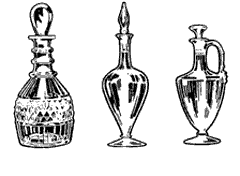
This allows the light to shine through, and the connoisseur will probably add that the simpler the form and the less embellishment in the way of cutting there is the better, as few things are more beautiful on the well-set table than the way the lights are reflected from the simply-curved surfaces of fine glass.

